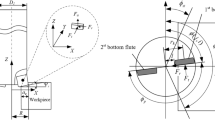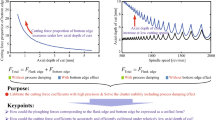Abstract
The cutting force signal distortion is caused by the dynamic characteristics of cutting force testing system. In order to handle this issue, we propose two improvements in the traditional inverse filtering technology. Firstly, we use three-spline interpolation method instead of the curve fitting method to fit the frequency response function of the test system which basically improves the accuracy of fitting. Secondly, the low-pass filter is added before the inverse filter to eliminate the influence of the high-frequency noise signal on the cutting force signal. We choose the cavity-free surface of outer covering parts of mold of automobile as research objects. The inverse filter dynamic compensation technology has been used to remove the influence of the dynamic characteristics of the test system and the high-frequency noise on the cutting force signal. The effectiveness of the proposed method is verified by relative milling experiments. Based on the experimentally measured forces after dynamic compensation, the modified cutting force coefficients are obtained using the average milling force method. The variation law of the cutting force coefficients with the axial depth, the radial width, and the feed rate is examined. Based on the modified variable cutting force coefficients, the 3D stability of the ball end milling cutter surface has been obtained using full-discretization approach. Combining the results from the cutting experiment and the nonlinear method, the stability prediction based on the modified variable cutting force coefficient can improve the prediction accuracy. The results provide theoretical support for the optimization of the machining process of the cavity-free surface of outer covering parts of mold of automobile.
Similar content being viewed by others
References
Wu S, Yang L, Liu XL, Zheng ML, Li RY (2017) Effects of curvature characteristics of sculptured surface on chatter stability for die milling. Int J Adv Manuf Technol 89(9–12):2649–2662
Yue CX, Gao HN, Liu XL (2017) Research on the stability of the machining process based on the dynamic cutting force coefficient. Chin J Mech Eng 53(17):193–201
Song Q, Ai X, Tang W (2011) Prediction of simultaneous dynamic stability limit of time-variable parameters system in thin-walled workpiece high-speed milling processes. Int J Adv Manuf Technol 55(9):883–889
Wan M, Zhang WH, Qin GH (2008) Strategies for error prediction and error control in peripheral milling of thin-walled workpiece. Int J Mach Tools Manuf 48(12):1366–1374
Li H, Li Y, Mou W (2017) Sculptured surface-oriented machining error synthesis modeling for five-axis machine tool accuracy design optimization. Int J Adv Manuf Technol 89(9–12):3285–3298
Budak E, Altintas Y, Armarego EJA (1996) Prediction of milling force coefficients from orthogonal cutting data. J Manuf Sci Eng 118(2):216–224
Wang JJJ, Zheng CM (2002) Identification of shearing and ploughing cutting constants from average forces in ball-end milling. Int J Mach Tools Manuf 42(6):695–705
Gonzalo O, Beristain J, Jauregi H (2010) A method for the identification of the specific force coefficients for mechanistic milling simulation. Int J Mach Tools Manuf 50(9):765–774
Altintas Y, Ber AA (2001) Manufacturing automation: metal cutting mechanics, machine tool vibrations, and CNC design. Appl Mech Rev 54(2):84
Yao ZQ, Liang XG, Luo L (2013) A chatter free calibration method for determining cutter runout and cutting force coefficients in ball-end milling. J Mater Process Technol 213(9):1575–1587
Lee P, Altintas Y (1996) Prediction of ball-end milling forces from orthogonal cutting data. Int J Mach Tools Manuf 36(9):1059–1072
Wan M, Ma YC, Feng J, Zhang WH (2016) Study of static and dynamic ploughing mechanisms by establishing generalized model with static milling forces. Int J Mech Sci 114:120–131
Wan M, Feng J, Ma YC, Zhang WH (2017) Identification of milling process damping using operational modal analysis. Int J Mach Tools Manuf 122:120–131
Magnevall M, Lundblad M, Ahlin K (2012) High frequency measurements of cutting forces in milling by inverse filtering. Mach Sci Technol 16(4):487–500
Tlusty J, Jang DY, Tarng YS (1987) Measurements of milling force over a wide frequency range. In Proceedings of the 15th NAMRC, Lehigh University, Bethlehem 273–280
Lapujoulade F (1997) Measuring of cutting forces during fast transient periods. 1st French and German Conference on High Speed Machining, Metz, France 372–376
Castro LR, Vieville P, Lipinski P (2006) Correction of dynamic effects on force measurements made with piezoelectric dynamometers. Int J Mach Tools Manuf 46(14):1707–1715
Park SS, Altintas Y (2004) Dynamic compensation of spindle integrated force sensors with Kalman filter. J Dyn Sys-t Asme 126(3):443–452
Albrecht A, Park SS, Altintas Y (2005) High frequency bandwidth cutting force measurement in milling using capacitance displacement sensors. Int J Mach Tools Manuf 45(9):993–1008
Chae J, Park SS (2007) High frequency bandwidth measurements of micro cutting forces. Int J Mach Tools Manuf 47(9):1433–1441
Wan M, Yin W, Zhang WH (2017) Improved inverse filter for the correction of distorted measured cutting forces. Int J Mech Sci 120:276–285
Jensen SA, Shin YC, Davies P (1996) Inverse filtering of unwanted system dynamics in cutting force measurement. Am Soci Mech Eng Dyn Syst. AND Control Division (Publication) DSC 58: 167-174
Castro LR, Viéville P, Lipinski P (2006) Correction of dynamic effects on force measurements made with piezoelectric dynamometers. Int J Mach Tools Manuf 46(14):1707–1715
Girardin F, Remond D, Rigal JF (2010) High frequency correction of dynamometer for cutting force observation in milling. J Manuf Sci Eng 132(3):031002–031008
Yue CX, Liu XL, Liang SY (2017) A model for predicting chatter stability considering contact characteristic between milling cutter and workpiece. Int J Adv Manuf Technol 88(5–8):2345–2354
Wan M, Ma YC, Zhang WH, Yang Y (2015) Study on the construction mechanism of stability lobes in milling process with multiple modes. Int J Adv Manuf Technol 79(1–4):589–603
Song Q, Shi J, Liu Z (2017) A time-space discretization method in milling stability prediction of thin-walled component. Int J Adv Manuf Technol 89(9–12):2675–2689
Wan M, Dang XB, Zhang WH, Yang Y (2018) Optimization and improvement of stable processing condition by attaching additional masses for milling of thin-walled workpiece. Mech Syst Signal Process 103:196–215
Liu X, Li R, Wu S (2017) A prediction method of milling chatter stability for complex surface mold. Int J Adv Manuf Technol 89(9–12):2637–2648
Rubeo MA, Schmitz TL (2016) Mechanistic force model coefficients: a comparison of linear regression and nonlinear optimization. Precis Eng 45:311–321
Grossi N, Sallese L, Scippa A (2015) Speed-varying cutting force coefficient identification in milling. Precis Eng 42:321–334
Acknowledgements
This project is supported by the State Program of National Natural Science Foundation of China (51575147) and the Youth Talent Support Program of Harbin University of Science and Technology (201507).
Author information
Authors and Affiliations
Corresponding author
Rights and permissions
About this article
Cite this article
Liu, X., Gao, H., Yue, C. et al. Investigation of the milling stability based on modified variable cutting force coefficients. Int J Adv Manuf Technol 96, 2991–3002 (2018). https://doi.org/10.1007/s00170-018-1780-9
Received:
Accepted:
Published:
Issue Date:
DOI: https://doi.org/10.1007/s00170-018-1780-9




